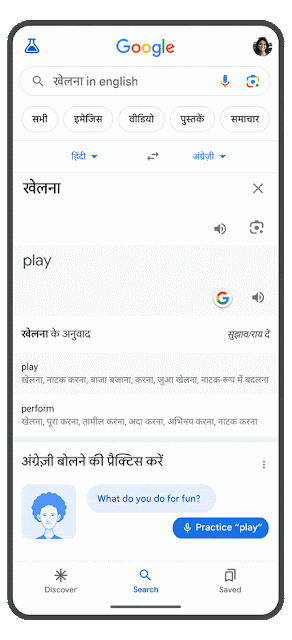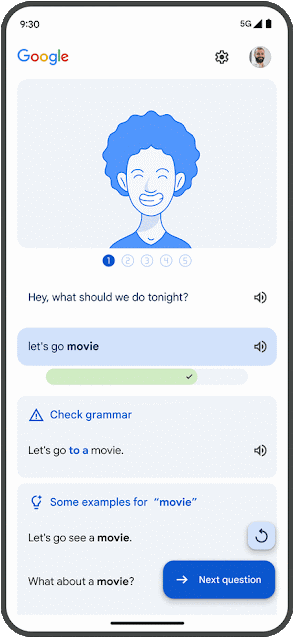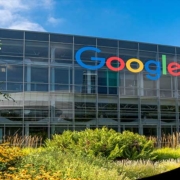Google’s AI-Powered Language Learning Unveiled
Google has rolled out an innovative feature on its search engine designed to boost language skills through interactive speaking practice. Available initially to Android users in six countries, this AI-powered tool focuses on aiding English learning, with plans to expand to more languages soon. Users can engage with real-life conversational prompts, allowing them to practice and refine their use of English in a dynamic, context-rich environment. This method draws parallels to language learning platforms like Duolingo.
Speaking practice —new AI experiment on Google’s Search Labs! pic.twitter.com/ZqzyvgXNUZ
— ㆅ (@howfxr) April 25, 2024
Enhanced Learning Through Google Search

In sessions lasting between three to five minutes, learners receive tailored advice on their performance, helping them continuously improve their language abilities directly from their smartphones. This new feature is not meant to replace traditional learning methods such as apps, tutoring, or classes but to complement them. Created in collaboration with linguists and educational experts, Google’s tool is crafted to inspire users to become more proficient and confident speakers.
Key to this experience is the reinforcement of vocabulary in realistic scenarios, which is crucial for better retention. Personalized, real-time feedback is a cornerstone of the service; a sophisticated deep learning model evaluates audio responses to deliver immediate corrections and suggestions.
In a recent blog post, Google Research Director Christian Plagemann and Product Manager Katya Cox shared insights into the feature’s development: “Google Search has long been a valuable resource for language learners, offering translations, definitions, and other tools to enhance vocabulary. Now, with the new English speaking practice feature, learners can enjoy a more immersive experience with customized feedback tailored to their needs.” This system not only provides semantic feedback—ensuring responses are pertinent and understandable—but also offers grammatical suggestions and examples of more complex language use, thereby enriching the user’s learning journey.
Google has enhanced its speaking practice feature by adapting models originally developed for written language corrections to now handle spoken speech transcriptions. By training on a mix of human and computer-generated transcripts, these models show significantly improved correction rates over those trained solely on text. Additionally, AI plays a pivotal role in developing instructional content, including prompts, vocabulary lists, and conversational responses, all of which are subsequently vetted by experts.
The tech giant has also introduced a new machine learning model that assesses the complexity of words, phrases, and sentences. This enables the system to tailor activities and suggestions to each user’s proficiency level, providing challenges that are just right for their stage of learning.
To further aid practical language acquisition, Google has developed advanced contextual translation technology. This feature allows users to tap on individual words to get definitions that consider the word’s context within a sentence, helping to clarify meanings that might be ambiguous when viewed in isolation. Google claims this technology achieves state-of-the-art accuracy, notably enhancing functionalities such as Chrome’s webpage translation.
Highlighting the underlying technology, the researchers explain, “A crucial element of this functionality is a novel deep learning model developed in partnership with the Google Translate team, named Deep Aligner. The core concept involves taking a multilingual language model trained on numerous languages and then fine-tuning it using a novel alignment model on a collection of word alignment examples provided by human experts across several language pairs.” This strategic approach ensures that learners receive the most precise and contextually relevant translation possible.
Google Integrates AI to Teach and Transform

Google’s latest speaking practice feature marks a transformative step for Search, evolving it from a mere repository of information into a personalized AI tutor. This technology holds the potential to expand into teaching a variety of subjects, although currently, Google is primarily focused on helping language learners become proficient speakers and fostering global connections. The possibilities are vast if Google Search evolves into a comprehensive AI educator.
Google Search has been progressively incorporating AI-driven enhancements throughout the year. Most recently, it introduced generative AI capabilities into its search responses, allowing for the creation of images and text directly from user queries. The text-to-image tool, integrated within the search results, enables users to refine descriptions, adjust image details, and export their customized creations. This innovation followed the addition of other generative AI features, such as improved definitions, code explanations, and webpage summaries. The integration of synthetic media tools within Search represents a significant leap forward, paralleling Google’s efforts to combine its Bard generative AI with Google Assistant to forge a multimodal Assistant enhanced by Bard’s capabilities.







